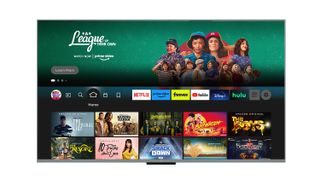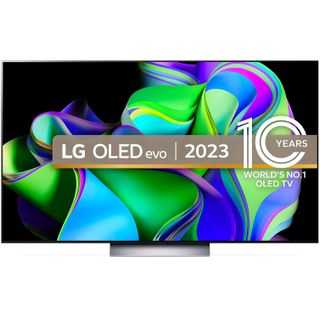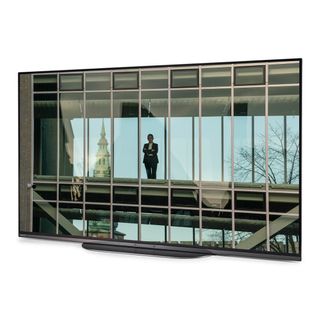
1. The list in brief
2. Best overall
3. Best budget
4. Best for sound
5. Also consider
6. How to choose
7. How we test
8. Recent updates
9. F.A.Q
50 inches is a convenient size of TV for anyone living in a small to medium-sized flat or house. But, it’s also a tricky size to buy as it sits in an awkward place in most TV lines.
Specifically, it tends to either be the largest option in an affordable line, or the entry-level in larger TV families. This means there are 50-inch TVs available for pretty much every budget. While that choice is awesome, having reviewed numerous 50-inch TVs over the decades, our team of testers can safely confirm there are plenty of 50-inch sets doing the rounds that may look awesome but fail to deliver in key areas with real-world use.
Common issues we face reviewing 50-inch TVs include terrible sound, sub-par black levels, particularly in the lower end of the market, and a lack of support for key gaming features, like HDMI 2.1 connectivity. The latter is essential to run current generation Xbox Series X/S and PS5 consoles at full speed. Even at the top end of the market poor pricing can make many premium 50-inch TVs poor value for money.
You can get a detailed breakdown of how we test 50-inch TVs at the bottom of this page, but the short version is that we check all of these factors in our dedicated viewing rooms before recommending a set in this guide.

I’ve been testing TVs for over a decade, and 50 inches is always one of the trickiest sizes to test. This is because it’s the middle option in most lines, being too big to be described as a second TV for most homes, but too small to fit into the big screen category. It’s also one of the most prevalent with most uber-affordable LCD lines offering a 50-inch option and OLEDs a slightly smaller 48-inch option. It’s one of the trickiest sizes to buy, especially by our hallowed performance-per-pound metric, as a result – which is also why the team and I make sure to properly test them whenever we get them into our viewing rooms.
Recent updates
25th March 2024: New intro, author bio, top tips, also consider how we choose and how we test sections.
The quick list

Best overall
The LG C3’s vibrant picture and extensive feature set still make it the best option around this size for most people.

Best budget
Budget TVs are hard to get right, but the 50-inch Omni QLED succeeds where others have failed thanks to a consistent, considered performance and impressive feature set.

Best for sound
With its super-detailed image quality and innovative sound system, the Sony A90K has to be considered by those with the means.
Best overall
As many will already be well aware, the C3 is the latest in LG’s long-running and stonkingly popular C-series of OLED TVs. That popularity is well-earned: LG’s C-series has been a near-perfect intersection of performance, features and price for years, and not just compared with other LG OLEDs, but with TVs in general.
The latest model is no different. For a start, there’s simply not a better-specified TV available at this size. While neither MLA nor QD-OLED technology has made it below 55 inches yet, the C3 uses the best 48-inch OLED panel currently available from sister company LG Display, and it's crisp and well-defined, producing an image that’s really solid and has a three-dimensional feel. In fact, the increased pixel density of having a 4K resolution squeezed into a 48-inch space means this smaller C3 looks significantly sharper than its 65-inch C3 sibling. The key TV battleground right now is gaming specs, and the 48-inch C3 very much has the high ground here too.
The 48-inch C3 launched at a higher price than the preceding C2 did, and that was a slight issue considering the mildness of the upgrades. It's not an issue now, though, as several discounts have been applies since launch and the OLED48C3 is now excellent value and has few serious rivals.
Read our full LG C3 review
Best budget
It’s fair to say that the standard of budget TVs has dropped significantly in recent years. Samsung, once the master of surprisingly capable and feature-packed budget models, struggles to scrape a four-star rating at the entry level these days, so we now have to look elsewhere for our televisual bargains.
Before we received the 65-inch Amazon Omni QLED in for review, we were expecting a TV packed with features and an eye-opening specification for the money, but likely short of cinematic quality. What we found was a TV that combined a very strong feature set and specs with surprisingly considered picture quality. So we were keen to do a dedicated review of the 50-inch model – and we're glad we did.
The Omni QLED’s performance is markedly more assured, considered and authentically cinematic than expected at this level, now or in the past. It clearly isn’t up there with the latest OLED models, such as the LG C3 above and Sony A90K below, but if those are out of reach this is an excellent compromise that will give you authentically cinematic entertainment for very little money (and effort).
Read our full Amazon Fire TV Omni QLED QL50F601 review

Buying a cheap 50-inch TV is a particularly dicey experience. This is largely because, while there are lots of affordable 50-inch LCDs doing the rounds, based on our testing most aren’t worth your money. Which is why the Amazon Fire TV Omni QLED was such a welcome surprise when we got it in for testing. But, before you go rushing to buy one, I’d recommend keeping an eye on Amazon’s deals section as this already great value TV is frequently discounted, sometimes by over 15-20 per cent.
Best for sound
For reasons unknown, Sony didn’t launch a new 48-inch OLED TV in 2021. Instead, 2020’s A9 (A9S in the US) was tasked with holding the fort against increasingly large ranks of rivals for almost two years. This appears to be a recurring theme, as Sony has once again omitted a 48-inch model in its 2023 lineup, instead sticking with the XR-48A90K.
Thankfully, the Sony XR-48A90K is still a great alternative to the company's new A95L QD-OLED, which isn't available below 55 inches.
It might not quite have the flawless gaming feature set of the LG C3 OLED above, but it’s close, and a very good gaming TV in its own right, particularly if you’re a PS5 player.
It's fair to say that movies come first with the A90K, though. It delivers an extraordinarily detailed rendition of everything you play through it and it majors on picture authenticity, particularly in terms of colours and contrast.
What perhaps sets it apart from the competition most, though, is the A90K's sound quality. It sounds a bit lightweight and thin compared to larger TVs such as its A80L and A95L stablemates, but it's very good by the standards of TVs this size, producing very clear and detailed audio. The Acoustic Surface Audio+ technology, which features actuators that vibrate the whole screen in order to make sound, also allows the set to sound very direct and spacious at the same time.
We always recommend adding a dedicated sound system, particularly when buying a premium TV such as this, but if you're determined not to add even a soundbar, the A90K is the 48-50-inch TV to buy.
Read the full Sony XR-48A90K review
Also consider
- LG G3: The LG G3 is about to be replaced by the LG G4, but if you want a 50-inch TV with solid gaming features to match the C3 and next-generation brightness-boosting MLA tech, it’s the best we’ve tested so far. It’s just not quite as good value as the C3, which is why it just missed out on making the main list.
- Philips OLED808: We reviewed the larger 55-inch model, but if you want a solid 50-inch OLED but don’t fancy the C3, then the Philips OLED808 is a great alternative. During our tests, although it’s not as good for gaming, it delivered solid picture quality and comes with the added allure of the company’s Ambilight bias lighting.
How to choose the best TV for you
First and foremost a 50-inch TV needs to deliver decent Picture quality. Whether it’s black-level performance running moody movies like The Batman, or reliable motion handling playing frantic sports fixtures, any 50-inch TV needs to deliver an immersive, accurate viewing experience for us to recommend it. If it suffers from key things, like muddy blacks, poor colour accuracy or distracting “soap opera effect” of over-processing then we won’t recommend it.
On top of that, we also expect it to be able to deliver “watchable” sound quality. We say “watchable” as audio is an area most modern TVs struggle with, even in the top end of the market. There are some exceptions, but this is largely due to modern TVs' slim dimensions, which make it hard to pack them with the hardware necessary to match most soundbars, let alone surround sound systems’ audio performance.
We also expect most TVs to include an adequate set of features to meet its target audience’s needs. For gamers, this includes things like whether it can run games faster than 60Hz, and has enough HDMI 2.1 connectivity to let it have more than one console connected alongside a Dolby Atmos soundbar. Many TVs, even expensive ones, still only have two HDMI 2.1 inputs, one of which doubles as an eARC. The latter is needed to connect a Dolby Atmos system.
For general entertainment, we also check app support to make sure commonly used platforms, like Netflix, Apple TV, Disney+, Amazon Instant Video and region-specific catchup services are supported.
We then factor price into our advice. Though we have a baseline of what we take as acceptable, we don’t expect a TV to match the performance of a rival that’s twice its price. Additionally, if a TV performs marginally better than a rival but is more expensive we’ll factor in whether we think the gains are worth the additional cost. For us to recommend it we have to feel the reader is getting great bang for their buck.
How we test TVs
Any 50-inch TV we review goes through a rigorous testing process in our dedicated London viewing rooms. During testing we apply the same checks we do to all other TV sizes.
Direct comparisons: Our testers never review in isolation or from memory. When we test a TV it is in our controlled viewing room which has been treated for sound and has controlled lighting conditions.
In addition, we will directly test it against any rival or step-down TV we think you’d also be considering. We do this using a TA-AN1000 to split the signal so we can run the same tests on each TV we’re comparing. That way we can draw direct comparisons of their performance.
Picture quality: We test 50-inch TVs' picture quality using a variety of sources. These include 4K Blu-ray test discs played using a Panasonic DP-UB820EB, and streaming services such as Netflix, Disney+ and their ilk.
We constantly update the test discs we use to reflect modern movie trends but always tailor our choices to a specific aspect of picture performance. For example, if we want to check shadow detail and black levels, we’ll opt for a dim, low brightness movie like The Batman, which is mastered at an atypically low 400 nits.
If we want to check max brightness, we’ll switch to a scene from a very bright movie, like Pan, which is mastered to a 4000 nit peak brightness. The same is true when we check HDR performance across the various standards.
We also test TVs’ upscaling capabilities using 1080p content on Netflix and DVDs, like True Grit, whose grainy quality causes most sets to struggle.
As part of the process, we will always make sure to tweak the 50-inch TV’s settings to get the best possible performance out of it. We don’t fully calibrate a TV during the process as this is a step beyond what most regular buyers would be able to do.
Audio quality: To gauge audio quality we run a series of demanding tests taking the same direct comparisons we do with picture quality. At the start, we will play a series of movies to gauge general performance and immersion levels.
But we’ll also do more difficult stress tests. These can include things like playing challenging scenes, such as the bass-heavy second scene of BladeRunner 2049, to check for things like distortion and speaker rattle. We’ll also check the TV’s various audio settings to get the best performance possible. On sets with Dolby Atmos in-built speaker systems, we’ll check performance here and see how effectively they can replicate the “dome of sound” experience.
App support and gaming features: We never take a TV’s spec sheet as gospel. As part of that, we’ll open popular apps, like Netflix and Disney+, to make sure they support and can output the HDR and surround standards they purport to – you’d be surprised how many don’t.
For gamers, we’ll do the same for things like VRR, 4K/120Hz and ALLM with a PS5 and Xbox Series X connected. We also check input lag using a Leo Bodnar device on any set we test, to make sure it can deal with competitive, reaction focussed games.
Recent updates
- Updated 20/03/24: Added new intro, top tips, also consider, how we choose, how we test and FAQ sections.
50-inch TV FAQ
Is 50-inches big enough for a lounge TV?
The best sized TV is always determined by the space you’re putting it in. That’s why we always recommend measuring your space before buying a TV. This is important as, while bigger screens can be more immersive to watch, they can take up a lot of space, and you want a reasonable viewing and listening distance to get the best experience possible. You can see how to do this in detail in our “which TV size should you buy?” guide.
However, 50-inches is generally a good option if you’re short on space, which is why we find they tend to work best in smaller living rooms, or larger bedrooms. The big thing to remember is that, if you want the best experience possible, you will want to invest in a soundbar or speaker package, so you should factor in the space for those as well.
Are 50-inch TVs good for gaming?
There are plenty of great 50-inch TVs for gaming. If you’re on a current generation Xbox Series X/S or PS5 games console, the big thing to check is if it can play games in 4K/120Hz. This requires an HDMI 2.1 input and is a key feature that lets the games play at smoother, higher frame rates than their predecessors. You’ll also want to make sure they support VRR and ALLM. Xbox owners will also ideally want one that supports Dolby Vision Gaming, though this is less of an issue for PS5 owners as Sony’s console doesn’t support the standard.
Are 48-inch OLEDs the best?
If you read What Hi-Fi? regularly, you’ll know OLED TVs are a staple fixture in our general best TV guide. But 48-inch OLEDs are still not as common as you’d think, and there are still a number of OLED TV ranges that start with 55-inch options. 48-inch options only tend to appear in step-down lines, like the LG C-series.
As to if these are always better than their LCD rivals, the answer is a firm 'it depends'. While they offer superior black levels due to the way they generate images by charging individual pixels, rather than a whole backlight, they don’t always perform better in other key metrics. We’ve tested plenty of LCD/Mini LED sets that offer better value, max brightness levels, colour accuracy and audio quality than competing OLEDs. You should never take OLED as an automatic badge of quality, and do your research on sites like What Hi-Fi? before buying a 50-inch TV.
How much should you spend on a 50-inch TV?
This depends on your budget and specific needs. 50-inch TV prices range from a few hundred bucks all the way up to thousands. On top of that, having compared numerous sets side-by-side, we can confirm that paying more doesn’t automatically mean getting the best 50-inch TV possible.
We recommend thinking about your specific needs. If you don’t game you can cut costs by not worrying about needing multiple HDMI 2.1 inputs. Equally if you just plan to watch terrestrial TV you probably don’t need to worry as much about apps’ HDR support. However, we would warn you that many of the latest sub-£400/$400 TVs we’ve tested have been outright terrible, featuring terrible picture processing, poor black levels and poor picture uniformity. Which is why the cheapest set we currently recommend still floats at around the £500/$500 mark.
Useful links
Why you can trust What Hi-Fi?
- Looking for a bargain? Here are the best cheap TVs
- Hardcore gamer? These are the very best gaming TVs
- Need a certain size? We've rounded-up the best 55-inch TVs
- Need something bigger? What about the best 65-inch TVs
- Want a future-proof TV? Here are the best 8K TVs
